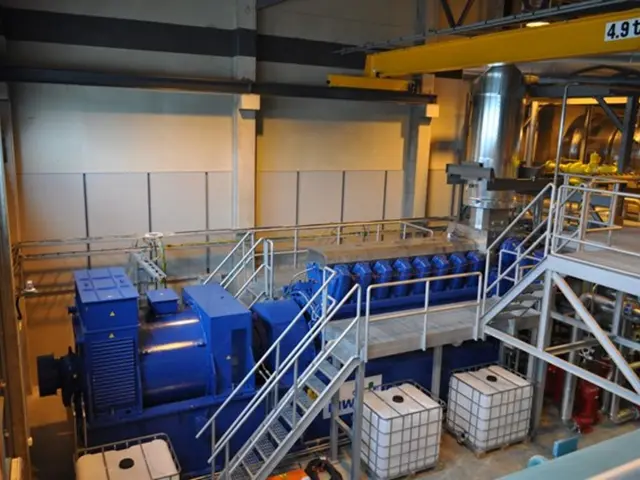Improved July rail freight figures, yet economic indicators cast doubts on the future outlook
U.S. Rail Freight Market Adapts to Economic Headwinds
The U.S. rail freight market is navigating a challenging economic landscape, marked by prolonged weak freight demand, evolving trade policies, inflationary pressures, manufacturing contraction, and capacity changes across freight modes. Despite these headwinds, the rail freight sector is demonstrating resilience, particularly through growth in intermodal volumes and stabilized spot rates.
Freight Downturn and Weak Demand
The U.S. freight sector is in the midst of the "Great Freight Recession 2025," with over three years of subdued demand and low spot rates. However, spot rates found a floor near $2.00 per mile in early 2025, signaling potential stabilization.
Trade Policy and Tariffs
Ongoing tariff adjustments under the Trump administration and U.S.-China trade negotiations create uncertainty affecting containerized imports, ocean freight volumes, and intermodal demand, influencing rail freight flows.
Inflation and Operational Costs
Inflation renewed pressure in mid-2025 with a 2.7% CPI year-over-year rise in June, increasing operational costs for rail carriers and complicating margin management.
Manufacturing Sector Contraction
The manufacturing PMI fell below 50 (48% in July 2025), indicating contraction with weak new orders, limiting industrial rail freight demand. The broader economic health depends also on the near-contraction service sector (PMI 50.1%).
Shifts in Modal Demand
Long-haul truckload demand dropped about 25% year-over-year as shippers shift toward rail intermodal for cost efficiency and inventory strategies ("rolling storage"), helping intermodal regain share.
Capacity Dynamics and Tariff Effects
Trucking capacity is shrinking due to increased carrier exits and equipment supply constraints, contributing to tightening capacity and tender rejections. Warehouse rents climb, prompting longer freight cycles using intermodal transit as quasi-storage.
Intermodal and Carload Volume Growth
Rail intermodal shipments rose by 2.4% year-over-year in July 2025, with total carloads up 2.8%. The AAR Freight Rail Index rose by 4% from June to July, reflecting growth across multiple commodities, including grain, coal, chemicals, and industrial products.
Resilience Despite Economic Headwinds
Rail freight is absorbing surges in import volumes at major ports (LOS Angeles, Long Beach) with rail handling volume increases of 18% to 24% from June to July 2025, mitigating spot rate spikes for trucking.
Spot-Contract Rate Dynamics
Contract rates remain ~35 cents per mile above spot rates, preserving shipper leverage but suggesting a potential catch-up in contract pricing late in 2025.
Capacity Adjustments and Rate Prospects
While truckload capacity remains ample for now, tightening is expected if demand stabilizes or rebounds, potentially creating rate gains in the second half of 2025 and more notably in 2026.
Market Outlook
Analysts project modest gains in spot and contract rates in H2 2025 and a more meaningful freight recovery in 2026, contingent on improved demand and continued capacity exits.
The next few months will be critical in determining the economy's future direction. Unemployment inched up to 4.2% in July, and the Consumer Price Index saw a 2.7% year-over-year rise in June. July's job growth figures showed only 73,000 new jobs added, far below the historical trend. The tally of discouraged workers reached 6.2 million in July. The U.S. economy posted an encouraging 3% annualized growth in the second quarter. However, consumer spending edged up by only 0.1% in June, marking its smallest year-over-year gain in 16 months. The economy is showing warning signs, according to Ghayad. Long-term unemployment reached levels unseen since December 2021.
Despite these challenges, the rail freight market is leveraging its intermodal capability and capacity management to maintain volumes and position for improvement as economic conditions potentially stabilize and improve toward 2026. Rail shipments of industrial products, including autos and steel, showed significant growth in July. The GDP growth is attributed to a reduction in goods imports and a positive inventory adjustment. The economy may either regain its footing or slip further into stagnation. The manufacturing sector has demonstrated resilience despite broader sectoral weaknesses. Total carloads were up 2.8% in July, and chemical shipments increased by 3.3%. The near-term outlook for freight railroads remains challenging.
Businesses across various sectors, including transportation, finance, and industry, are closely monitoring the rail freight market's progress amidst economic headwinds. The stabilization of spot rates in freight, despite three years of subdued demand and weak freight demand, indicates some level of businesses' resilience in the face of these challenges. Tariff adjustments, inflationary pressures, and evolving trade policies further influence trade dynamics, posing challenges for the business communities involved.




